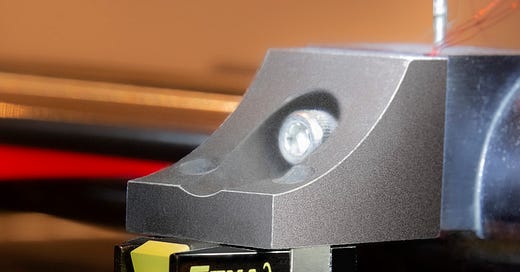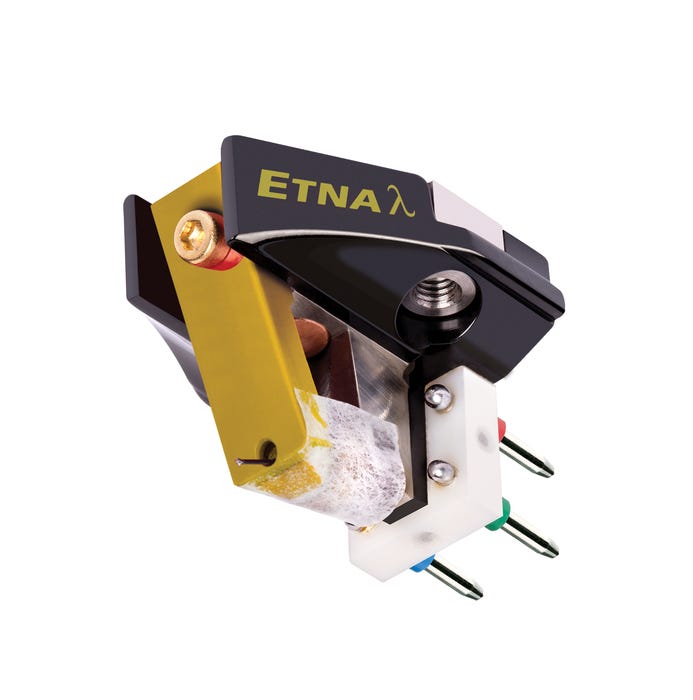Think of It as an Etna II
Product names typically serve as unspoken code between manufacturers and buyers. A newly appended roman numeral, or one that’s been incremented upward, indicates a new generation, with commensurately major upgrades. The signal to the user: You can expect a broad and substantial performance improvement. On the other hand, the use of a modifier in a new model name—unless preceded by the word “Reference”—signals small design changes and relatively minor (though still significant) performance improvements.
Lyra’s Etna Lambda, the latest version of its acclaimed Etna cartridge, runs afoul of these normally reliable conventions. Here we have a cartridge that’s been given the “Lambda” treatment—modest design tweaks—but the improvement is anything but minor. In fact, the Etna Lambda doesn’t sound like an incremental upgrade at all; rather, it sounds like a whole new, spectacular cartridge.
Regular readers will recall that both Jacob Heilbrunn. and I heaped praise on the pre-Lambda Etna. Jacob reviewed the SL (low-output), and I followed up with a write-up of the standard (normal-output) version. You can read those full reviews on the TAS website, but to summarize, Jacob gushed that the Etna SL delivers “transient precision, a blackness to the background (and) a creaminess to the midrange that seems to suppress noise while widening the dynamic envelope.” He also noted the cartridge offers a “layering of the soundstage, each instrument firmly located in its space rather than wavering, thereby adding a notable sense of verisimilitude to the proceedings.”
I found that the non-SL Etna performed similarly, adding that its overall nature is “seductive” and concluding by stating that the Etna makes “musical magic.” That’s high praise, indeed. So high that it’s hard to imagine the Lambda Edition being better, let alone way better. But it is.
The first hint comes before music even starts playing—during the lead-in grooves. There is so much less groove noise, I found myself wondering if my tonearm’s cueing system had gotten stuck in the up position. Nope. Instead, this silence turns out to be just one manifestation of the Lambda’s absence of mechanical noise.
Of course, the real testament to what Lyra has achieved comes when the music begins. The reduction of noise from cartridge mechanics allows previously hidden musical mechanics to emerge. For instance, with the Lambda I can hear Bruce Springsteen’s fingers brushing his guitar strings on “The Ghost of Tom Joad”—a previously obscured detail. The Boss’ voice, too, is less prone to sibilance and generally more relaxed. Another big change I notice on this track: more powerful and incisive bass than you get from the pre-Lambda Etna.
The Lyrita LP of Moeran’s Symphony in G Minor is another, very different showcase of where the Lambda Edition and the standard Etna part ways. The Lambda manages to maintain—and even reinforce—the innate lushness of the previous Etna, but it does so without adding any trace of heaviness. Images are even more solid and fleshed out than before. Meanwhile, timbres are more realistic-sounding, and the soundstage is notably deeper.
If that weren’t enough, consider one more example, the famous Royal Ballet Gala Performances LP, originally on RCA Victor. Here, the strings, which are notoriously difficult to reproduce, show great gains. They are meatier, yet less shrill.
So how did Lyra achieve these feats? Primarily, through just two strategic tweaks. I can’t describe the first of these as well as Lyra designer Jonathan Carr, so I’m going to quote him. “First, a bit of background that applies to both the pre-Lambda and Lambda Etnas. Ideally, a stylus should follow the shape of the LP groove and nothing else. But in a moving-coil cartridge, the pull between the coil armature and the magnet/polepiece, a pull that varies with the distance between those two elements, introduces a conflicting force. This force makes the movement of the stylus more erratic and less under the control of the LP groove.”
“The typical method of counteracting this pull is to make the suspension stiffer. But while this does make the armature less likely to waver due to magnetic pull, it also makes the stylus harder to move, which can necessitate the use of higher VTF (vertical tracking force) and/or adversely affect tracking performance. Lyra feels that there is great value in keeping vertical tracking forces low (less wear to both the stylus and the LP) while prioritizing tracking ability (better performance and sound on more LPs)."
“We therefore developed our New Angle technology, which is a mechanical preloading system that pushes the cantilever down towards the LP by a predetermined amount when VTF is not being applied to the cartridge. That way, the application of VTF causes the armature and front/rear magnets (we don't use polepieces) to become parallel to each other. Having the armature and magnets parallel when playing an LP significantly reduces pulling forces, making it possible for us to use a softer suspension, thereby achieving higher tracking performance without the need to impose high VTF requirements.”
“The difference between the pre-Lambda and Lambda versions of the Etna is that they use different means to achieve cantilever preloading. The pre-Lambda Etna employed dampers that were tapered like a shallow wedge, whereas the Lambda version uses a system of flat dampers with a separate support structure we call the ‘pillow.’ The flat dampers ensure that the preloading of the cantilever angle is optimal and remains entirely in the vertical domain. This allows greater consistency in all aspects of performance. The revised design and new, specialized materials result in superior tracking and dynamics, as well as a lower noise floor for superior detail retrieval.”
Now I don’t know about you, but to me these sound like the tweakiest of tweaks. Flat dampers versus wedges? How much could that change the sound? Nonetheless, the results speak for themselves.
The second alteration in the Lambda Edition is easier to describe. Simply put, the new olive-colored front piece is now made from some stronger, more rigid industrial polymers. Note that these changes were applied to what was already a highly advanced and unique cartridge design. To recap, all Etnas feature: a single-assembly stylus/cantilever mounted directly to a “nude” body to reduce resonances; an asymmetrical design that offsets the screw securing the front magnet carrier, so that it isn't in line with the cantilever mounting points; a solid titanium core structure machined with non-parallel surfaces to inhibit internal reflections; a slightly undersized anodized duralumin outer body that locks over the core; a yokeless dual-magnet system; a diamond-coated boron rod cantilever and Lyra-designed variable-radius line-contact stylus; and X-shaped signal coils rather than the usual square-shaped coils.
As you can see, much more stayed the same—including the stylus, cantilever, coils, and overall structure—when Lyra created the Lambda series. In that respect, Lyra was correct in not calling this the Etna II. However, from a sonic perspective, the latter would have been fully justified. The Etna Lambda isn’t a cartridge that, upon first listening, elicits a “Ah, that sounds a little better here and there.” Rather, your reaction is likely to be closer to mine: “Holy cow! This thing sounds fantastic!”
For any Etna owner (including owners of the SL, which is also now available in a Lambda Edition), the Lambda is an unquestionably worthwhile upgrade. Lyra will rebuild yours to the latest spec for $4495. For non-Etna owners shopping for a superlative cartridge in this price range, the improvement in the Lambda is even more reason to put the Etna at the top of your list.






